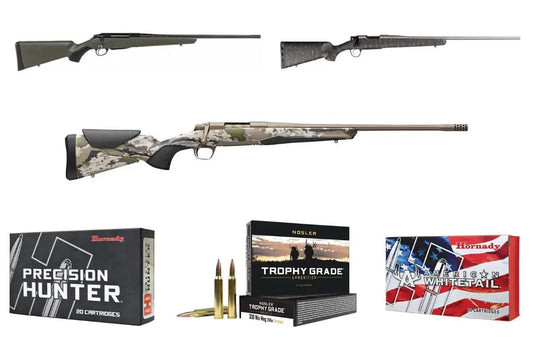
.260 Remington: Forgotten Gem or Underrated Workhorse for Mid-Sized Game Hunting?
🧠 Summary Table: .260 Remington for Mid-Sized Game Hunting
|
Feature |
Description |
|
Introduced |
1997 by Remington |
|
Parent Case |
.308 Winchester |
|
Bullet Diameter |
.264 in (6.5mm) |
|
Max Pressure |
60,000 psi |
|
Best Use Case |
Mid-sized game hunting (deer, antelope, hogs) |
|
Ballistic Performance |
High BC, flat shooting, low wind drift |
|
Popular Competitors |
6.5 Creedmoor, .243 Win, .308 Win |
|
Factory Ammo Availability |
Scarce |
|
Reloading Potential |
Excellent |
|
Gun Options |
Limited but high-quality builds from Savage, Christensen Arms, and Tikka |
|
Viability Verdict |
Not dead yet—niche but outstanding in its lane |
In a market overrun with trendy cartridges, from the meteoric rise of the 6.5 Creedmoor to the enduring legacy of the .308 Winchester, the .260 Remington often finds itself relegated to the dusty corners of the gun shop or ignored entirely in online forums. But labeling it a “dead caliber” is, frankly, lazy. The .260 Rem may not be the hottest round in the deer woods, but it's far from obsolete—especially for the discerning hunter who values ballistic efficiency, mild recoil, and reloadability over hype.
In this deep-dive, we’ll look at what makes the .260 Remington a technical gem, why it’s overlooked, and whether it deserves to be in your gun safe—or on your next elk tag.
TL;DR for Skimmers
- .260 Remington is not dead—just niche.
- Ballistically superior to .308 and .243 Win in many contexts.
- Matches or exceeds 6.5 Creedmoor performance when handloaded.
- Factory ammo is scarce, but reloading solves the problem.
- Ideal for deer, hogs, antelope, and even elk with proper shot placement.
- Limited rifle options, but standout platforms exist (e.g., Savage 110 Tactical, Christensen Arms Mesa, Tikka T3x).
- A smart pick for serious hunters and reloaders looking to bypass Creedmoor clichés.
🎯 What Is the .260 Remington, Really?
The .260 Remington, also known by its wildcat designation 6.5-08 A-Square, is essentially a .308 Winchester necked down to accept a .264" bullet. That puts it in the same family as 6.5 Creedmoor, 6.5x55 Swedish, and 6.5 PRC—cartridges beloved for their flat trajectories and high ballistic coefficients (BCs).
Key Ballistic Specs:
- Bullet Diameter: .264 in (6.5mm)
- Case Length: 2.035 in
- Overall Length: 2.8 in
- Maximum Pressure: 60,000 psi (SAAMI)
- Typical Bullet Weights: 120gr to 140gr
- Muzzle Velocity (140gr): ~2,750 fps from a 24” barrel
The result? A cartridge that flies flatter than a .308, kicks less, and still hits with authority out to 500+ yards.
“The .260 is one of the best-balanced cartridges ever designed for North American game under 500 pounds. It never got the marketing push it deserved.”
— John Barsness, ballistics writer and contributor to "Rifle" magazine
🧪 Ballistics & Performance: Where It Shines
✅ Pros:
- High Ballistic Coefficient (BC): A 140gr Hornady ELD-M in .260 Rem has a G1 BC of .610. That’s on par with or better than many Creedmoor loads.
- Low Recoil: With ~12-13 ft-lbs of recoil energy, it’s extremely shootable—even for smaller-framed hunters.
- Superior Trajectory: Shoots flatter than .308 Win with less wind drift.
- Effective Terminal Ballistics: With a sectional density of 0.287 for 140gr, penetration on deer, hogs, and even elk is excellent.
- Ideal Barrel Life: Better than 6.5 PRC or 6.5-284, which can torch barrels after 1000-1200 rounds.
❌ Cons:
- Scarce Factory Ammunition: Federal, Nosler, and Hornady still make it—but in limited runs. Availability is sporadic at best.
- Few Rifle Options: Most manufacturers focus on Creedmoor. Custom builds or niche brands like Savage or Christensen Arms may be your best bet.
- Not “Tactical” Enough: It lacks Creedmoor's PRS and long-range shooting community clout, which affects accessories and development.
🔍 Head-to-Head: .260 Remington vs. Competitors
|
Cartridge |
Muzzle Velocity (140gr) |
Recoil Energy |
Trajectory (500 yds) |
BC (G1) |
Barrel Life |
|
.260 Remington |
~2,750 fps |
~13 ft-lbs |
-52" drop |
0.610 |
3,000+ rounds |
|
6.5 Creedmoor |
~2,700 fps |
~14 ft-lbs |
-53" drop |
0.610 |
2,000-2,500 |
|
.308 Winchester |
~2,650 fps (150gr) |
~17 ft-lbs |
-60" drop |
0.435 |
5,000+ |
|
.243 Winchester |
~3,000 fps (100gr) |
~10 ft-lbs |
-48" drop |
0.355 |
3,000+ |
Takeaway: The .260 Rem splits the difference beautifully—better energy retention than .243, less recoil than .308, and nearly identical performance to 6.5 Creedmoor.
🧰 Best Factory Rifles Chambered in .260 Remington
Despite a dwindling number of SKUs, a few standouts remain:
- Adjustable AccuFit stock
- Threaded heavy barrel
- Detachable box mag
- Price: ~$780
- Carbon fiber stock
- Sub-MOA guarantee
- Stainless steel, featherlight build
- Price: ~$1,300
- Legendary Finnish precision
- Featherweight at ~6.5 lbs
- Crisp trigger and cold-hammer forged barrel
- Price: ~$750
For a custom or semi-custom rig, consider starting with a short-action Remington 700 or Howa 1500 action and build around match-grade .260 barrels from Krieger, Bartlein, or Proof Research.
🧱 Ammo Options: What's Left in 2025?
Factory ammo is tough to find—but still out there. Top picks include:
Federal Premium 140gr Nosler Partition
- Outstanding for elk or big mule deer.
- Price: ~$45/box
- Great for precision and long-range hunting.
- Price: ~$42/box
Nosler Trophy Grade 130gr AccuBond
- Deadly and accurate at any hunting range.
- Price: ~$48/box
🧪 Reloading: The Key to Longevity
If you reload—and you should for .260—this round becomes a beast.
- Powders: H4350, RL-17, IMR 4451
- Bullets: Hornady 143 ELD-X, Sierra GameKing 140gr, Nosler 130gr AccuBond
- Brass: Lapua and Peterson make premium offerings
- Primers: CCI 200 or Federal 210
Best Load Example:
- Bullet: 140gr ELD-M
- Powder: 41.5gr of H4350
- COAL: 2.800”
- Velocity: ~2,775 fps (from a 24" barrel)
This load offers sub-MOA accuracy, excellent terminal ballistics, and enough retained energy to drop a 300-lb mule deer at 500 yards.
🏹 Is It Viable for Mid-Sized Game?
Absolutely.
🦌 What Can You Hunt with the .260 Rem?
- Whitetail & Mule Deer: One-shot kills with 120–140gr bullets are routine.
- Antelope: Flat shooting makes it perfect for the plains.
- Hogs: Penetrates dense shoulder plates cleanly.
- Black Bear: With premium 140gr bullets, the .260 is lethal.
- Elk: Controversial, but doable with premium bullets and disciplined shot placement. Many guides report success inside 400 yards.
“I’ve seen more elk drop to a 140gr AccuBond from a .260 than to a .300 Win Mag when shot placement was ideal. Bullet matters more than caliber.”
— Tom Beckstrand, former SOF sniper and rifle editor, Guns & Ammo
📉 Why Did It Fade?
- Poor Marketing: Remington never pushed it hard; Creedmoor got the PRS community behind it.
- Timing: Released before long-range shooting became trendy.
- Factory Support: Less ammo on shelves discouraged mainstream adoption.
🔮 Future Outlook: Comeback Kid or Collector’s Curiosity?
Prediction: The .260 Remington will never dethrone the 6.5 Creedmoor, but it’s not dead either. It will retain a cult following among reloaders and traditionalists who know how to squeeze every bit of performance from it. Like the .280 Ackley or .257 Roberts, it occupies a premium, if quiet, space.
For those willing to handload and chase performance over popularity, the .260 Rem is arguably the best mid-game hunting cartridge you’re not using.
Final Verdict: Buy, Reload, and Hunt On
If you're a hunter who:
- Values ballistic performance over Instagram buzz
- Prefers tuning their own loads
- Wants sub-MOA accuracy with minimal recoil
- Doesn't mind sourcing rare ammo
...then the .260 Remington belongs in your collection.
It’s not a dead caliber. It’s a neglected gem waiting for rediscovery.
🛒 Ready to Buy a .260 Remington Rifle or Ammo?
👉 Shop .260 Remington Products at SCHEELS.com.



